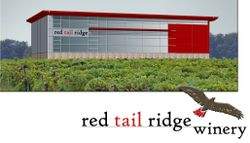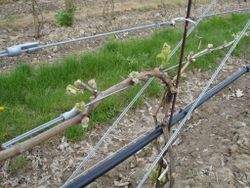By Jason Feulner, Finger Lakes Correspondent

While the basic strategy for opening a functional winery differs from region to region, in the Finger Lakes the trend seems to follow a path that calls for the opening of the tasting room first with production facility and vineyard coming later.
While this might be a generalization of sorts, it makes sense in many respects. Nearly 75% of wine sales in the Finger Lakes occur on site; many larger wineries lease production space; and a vineyard takes quite a few years to produce grapes.
A winemaker or entrepreneur can purchase grapes, make wine at a different facility, and then sell it in a tasting room to raise capital for the eventual construction of the production facility and vineyard. I can think of several newer Finger Lakes wineries that have gone this route. Most importantly, the tasting rooms are placed prominently next to main roads so that wandering tourists will stop inside and spend their money.
Not so at Red Tail Ridge. When I visited this new winery last summer on the western shore of Seneca Lake, the progression of the operation struck me as unique. The well-marked entrance from Route 14 invites visitors up a long, winding dirt road, but there is no sign of a tasting room at all. In fact, all one can see up and over the rolling hill are acres and acres of vines.
These are impressive rows of young vines, well spaced and groomed with thick trellises anchored so securely that it looks like a raging tornado would leave the plants intact.

As the dirt road deposits you in the midst of this 30-plus acre vineyard, it's difficult not to be surprised by the small, temporary-looking building that serves as the tasting room. The building looks so out-of-place in the middle of the vast vineyard because it is indeed temporary. Red Tail's owner and winemaker, Nancy Irelan, has bigger and better plans for the facility. She and her co-owner and husband Michael Schnelle want to try something a little different.
A 15-year veteran of the California wine industry and a Ph.D.-holding geneticist specializing in oenology, Nancy Irelan did not invest first in her vineyard based on a whim. She believes that wines are made in the vineyard, and while this may be the ultimate winemaking cliché, Irelan is very specific about what she means.
To find the fruit and aroma characteristics she is looking for, Irelan created the vineyard to be something akin to an experimental station, with several varieties under examination to gauge their promise in the region's cool growing climate. One such experiment is Teroldego, a rare red grape from northern Italy.
Irelan has planted many different clones of more popular varieties to see how to best find the flavor profiles she desires. The many rows of pinor noir are made up of several different clones, as Irelan feels that the right mixture of these clones might unlock the key to a wine that shows a lot of potential in the Finger Lakes at times, but in many instances falls a little flat.
The vineyard appears well-designed aesthetically, and this impression is not superficial. If prompted, Irelan can explain in detail all the decisions that were made concerning drainage (the property is extensively tiled), moisture control, erosion control, row spacing, etc. She emphasizes that the methodical nature of the design plan creates a sustainable vineyard that has a minimal environmental impact.
In this spirit, Red Tail Ridge has retained Edge Architecture PLLC to design a tasting room and production facility that carries the ultimate seal of environmental sustainability, LEED-platinum certification (Learn more about LEED certification). If built to the specification of its current conception (see the graphic at the top of this post), the Red Tail Ridge winery will be the only LEED-certified facility in the heart of the Finger Lakes and one of only a handful of environmentally advanced buildings in all of upstate New York.
Nancy Irelan and Michael Schnelle hope to break ground on the foundation of the new facility this spring.
So, does what does a unique building like this have to do with making good wine? Well, everything and nothing, as Irelan explains: "No, it will not have an effect on the wine, but that’s not why we are doing this. This may be 'just a building' to most folks, but it's probably the only winery that Michael and I will ever build, so it needs to be representative of us and our values. Sustainability is a part of our mind set and something that we believe in."
Admittedly, Irelan came to the Finger Lakes with an extensive capital plan (she originally assumed she would be investing in California's expensive industry) but she has taken the opportunity to use the region's flexible market to enhance her business. I have yet to taste samples of Red Tail Ridge's newest vintage, but I am excited about the dedication the owners are making to the region as well as the spirit they exhibit in creating a unique sense of place.
Red Tail Ridge as a destination will be something to behold, and that's never a bad thing.
